#Computer Vision Platform
Explore tagged Tumblr posts
Text
FPT Announces Strategic Partnership With Landing AI, Advancing Artificial Intelligence Development And Education
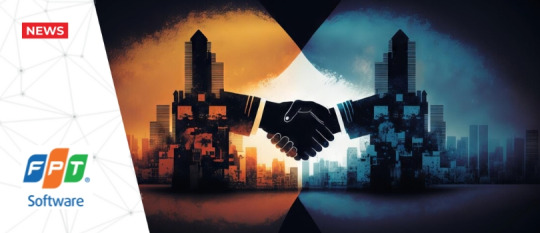
FPT, a multinational technology business with headquarters in Vietnam, and Landing AI, a well-known provider of AI software and computer vision solutions in the US, have partnered to advance AI applications and education. The partnership was announced during the FPT Techday 2023 in Hanoi, Vietnam, and involves FPT being a major investor in Landing AI as well as a strategic partner for the Asia Pacific area. It is anticipated that enhanced AI cooperation between the US and Vietnam would result from this alliance.
The primary goals of this collaboration between FPT and Landing AI are to investigate and cultivate unexplored market prospects across multiple industries, such as manufacturing, education, healthcare, and automotive. They intend to take advantage of FPT's broad network in the Asia-Pacific region as well as Landing AI's vast experience in these areas, notably in the North American market. This expands on an earlier contract that was started in 2022 between Landing AI and FPT Software, a subsidiary of FPT, to implement end-to-end visual inspection solutions throughout Asia by utilizing their respective AI skills.
Furthermore, FPT Software and Landing AI are thinking of opening an engineering facility specifically for that purpose in Vietnam. The goal of this center would be to produce a top-notch AI workforce and open up employment opportunities for both businesses. Concurrently, FPT Education will work with Dr. Andrew Ng, the CEO and founder of Landing AI, who was named one of Time Magazine's Top 100 Most Influential People in AI. FPT Education is the company's industry-focused private education program. It advises on AI development and aims to establish a thorough AI curriculum for students in grades 1 through 12.
Read More - https://bit.ly/498yqbB
1 note
·
View note
Text
#AI chatbot#AI ethics specialist#AI jobs#Ai Jobsbuster#AI landscape 2024#AI product manager#AI research scientist#AI software products#AI tools#Artificial Intelligence (AI)#BERT#Clarifai#computational graph#Computer Vision API#Content creation#Cortana#creativity#CRM platform#cybersecurity analyst#data scientist#deep learning#deep-learning framework#DeepMind#designing#distributed computing#efficiency#emotional analysis#Facebook AI research lab#game-playing#Google Duplex
0 notes
Text
Cloud & Devops Services | Nitor Infotech
In today's fast-paced digital landscape, cloud technology has emerged as a transformative force that empowers organizations to innovate, scale and adapt like never before. To know more about Nitor Infotech's services click on - https://bitly.ws/Zyt3
#nitorinfotech#blog#nitor#software development#software engineering#digital transformation#cloud computing#cloud software#clouds#cloudcore#cloud storage#cloud storage services#cloud computing trends#google cloud console#google cloud platform#google cloud#ascendion#gcp cloud vision#pillars of cloud#cloud engineering services#aws cloud migration services#what is cloud data storage#cloud pillar
0 notes
Text
Enhancing AI Services with Computer Vision: Transforming Perception into Intelligence
Experience the transformative potential of computer vision in artificial intelligence. Witness how this advanced technology empowers solutions to extract, comprehend, and respond to data from images, videos, and visual inputs. By harnessing cutting-edge machine learning and artificial intelligence, computer vision becomes the digital equivalent of human vision, revolutionizing industries. Explore the seamless integration of AI and computer vision, revolutionizing how we interpret the visual world.
#computer vision in artificial intelligence#legacy systems#legacy migration#travel management company#online travel agency#Customer Data Platform#Conversational AI#AI chatbot
1 note
·
View note
Text
Well. I have a feeling I'm about to have a million new followers. (March 31st, 2025; not an April Fool's joke, unless Nanowrimo has very poor taste and timing)
youtube
Here's a link that explains in long video format the whole entire thing in detail:
youtube
and to sum it up:
This blog was made as an Anti-Generative AI to Nanowrimo, as well as a way to actually build a friendly, low-pressure, helpful community of aspiring writers, without the hard-fast-do-it-or-die pressure brought on by nanowrimo.
There is no official "contest" -- only a community coming together to inspire each other to write, help out with motivation by setting community goals, keeping participation motivation via Trackbear.app, etc!
The most popular writing challenge is still November for most people, but I myself have also started to keep a year-round, daily writing goal of 444 via the website 4thewords, which has been an extreme help in getting me to write a little at a time.
This year has been very hectic for everyone what with the election results so I haven't been very active on tumblr (I think everyone can understand that) but I was originally planning on also having each month of the year being a different themed writing / art challenge but got a bit distracted real life.
So, what is the Novella November Challenge?
It's a fun challenge where writers come together to write 30,000 (or your own personal writing goal!) words in 30 days, sharing tips, writing advice, plot ideas, accessibility aids, and committing to having fun while explicitly fighting back against Generative AI by using our own words and disavowing the use of scraping and generating to take away the livelyhoods of artists of all spectrums, and proving everyone who insists "generative AI is an accessibility tool" wrong by committing to our creative visions and making it easier for everyone to find the tools they need to succeed by sharing tips, free programs, and finding a like-minded community to support you! 💙
There is no official website, there is no required place to show your participation, this is a community initiative that will never be monetized by predatory sponsors or dangerous moderators abusing their power.
This blog is here to inspire everyone, regardless of experience level, to write and create the story they want to tell, in their own words, while striving to remain a fun, low-pressure challenge that doesn't turn into a stressful spiral, like often happened with Nano.
Want to start writing but not sure how? Don't have money to spend on expensive writing programs? Have no fear!
LibreOffice: An always free, open-source alternative to Microsoft Word (and Microsoft's other office suits)
4Thewords: A website (both desktop and mobile web browser) that syncs your writing cross platform to the cloud, with built-in daily word goals, streak tracking, and you can fight monsters with your word count to game-ify writing!
Trackbear: A website dedicated to tracking your writing, setting custom goals, and creating leaderboards for community participation; you can join the year-long community leaderboard with the Join Code "f043cc66-6d5d-45b2-acf1-204626a727ba" and a November-limited one will release on November 1st as well.
Want to use Text to Speech to dictate your novel?
Most modern phones have a built-in option available on your keyboard settings which can be used on any writing program on your phone, and most modern PCs that allow a microphone (including headphone) connection has some kind of native dictation function, which you can find by opening your start panel and searching your computer for "Speech to text" or "voice to text".
Want to write while on the go, but don't want to / can't use the small phone keyboard to type, or speech to text?
You can, for as cheap as $40, buy a bluetooth keyboard that you can pair with your smart phone or tablet and use to write in any and all writing applications on your phone -- this allows you to write on the goal (especially using cross-platform websites or services, like 4thewords or google docs) , and the small screen can also help minimize distractions by muting notifications in your writing time.
#novella november#nanowrimo#large text#writing events#national novel writing month#community events#anti ai#novellanovember#Sam Beckett Voice: Oh boy#long post#Youtube
168 notes
·
View notes
Text
Hazbin Masterpost
Heavenbound Masterpost
Vox, the noisy video box
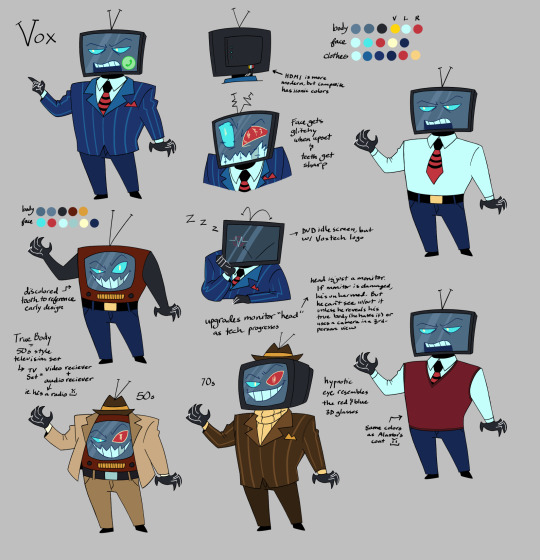

So Vox may not be my favorite character, but he is probably my favorite redesign. I laugh every time I look at him now. He looks like a weird mix of Spongebob, Kraang(TMNT), and Mr. Electric(Sharkboy and Lavagirl). He absolutely hates it.
Notes under the cut
There's too many twinks in this show. So when I was trying to decide which characters I could change, for body diversity, Vox was an obvious one. He needed more bulk so his body could conceivably support the old TV models. Those things could get heavy. The change also had the side effect of making him shorter, which just worked better proportionately.

I liked the idea that Vox could never get rid of his original bulky 50s TV, but also wanted him to be able to upgrade. So I decided his true body is the 50s TV, and he adds an upgraded monitor for a head as technology improves. He's hates that he's stuck as an old fashioned TV, so he hides that under his suit. Since the monitor is just an addition, it can be swapped out easily. It can be damaged and he's technically unharmed. But he can't see through his suit without the monitor, unless he wants to use a security camera and direct himself 3rd person style.
I didn't like that basically everyone has sharp teeth. It reduces the impact for characters like Alastor or Rosie. So I've been having the default be just sharp canines. But with Vox being a TV, there are so many possibilities. I gave Vox "regular" teeth, which helps him look more trustworthy. It fits the corrupt businessman vibe. But the appearance can change with his mood too.
Color TV became available in the 50s, so Vox always had color vision. But I think it'd be funny if, early on, he had a tendency to glitch out by going into black and white vision when he gets worked up. He's mostly grown out of that glitch, but he can't seem to shake the static or TV color bars, and developed new ones as he integrated computer and internet tech into himself as well. Now he gets the Blue Screen of Death, system errors, and city wide power surges.
Messing around with his face is so fun. When he's bored or tired a Voxtech logo will bounce around like the DVD logo, or display a screensaver. His face can get too big for the screen when he's excited, or be small when he's feeling embarrassed. I need to put a troll face on him at some point. It may be an old meme, but man, it feels right.
His left eye turns red when it's hypnotic, to reference those blue and red 3D glasses.
Of the three Vees, he is absolutely the most powerful. Val and Vel are the content creators, but Vox is the platform. The other two, while still powerful in their own right, would never have gotten to the level they're at if it weren't for Vox. He controls the mainstream media.
--TV set--
So we've got some interesting implications with how he functions. He's a TV, but he blue screens like a computer, and he shorts out the power grid. I think it's safe to say he is more than just a TV, he's a multimedia entertainment center. That, and TVs are starting to really blend with computers these days. He's mainstream media.
At some point, I realized that a TV set was a "set" because it wasn't just a single device. A television set was a collection of components, which boils down to a radio hooked up and synchronized to a visual display. I bring this up mostly because I am a sucker for one-sided radiostatic. It's so funny to me. Vox is obsessed.
But I'm going to refrain from too much theorizing about their relationship. Alastor is absolutely not interested in romance. Nor a QPR. He's not even interested in friendship. Alastor is too invested in power dynamics to really consider anyone a friend. Mimzy is probably the closest he has to a friend, and even that has manipulative elements on both sides. But I'm supposed to be talking about Vox!
--Human Vox!--
He is not tall, haha. But his proportions are a bit taller than his demon form. I wanted to go for square glasses, but I didn't see many examples of that in the 50s photos I found. Oh well! My goal was a sleazy business man. He probably had a variety of jobs, but they primarily involved TV. Commercials, PR, interviews, news, game shows, talk shows, screenwriting, etc. Whatever he could do to get more influence. He found himself favoring the business end of things. Making deals and pulling strings. He decided what would go on the air. He's one of those network executive types.
I see lots of people give him heterochromia, but I don't really see a point to that. He hypnotizes people with his left eye, sure, but it's not a different color. It's not disfigured in any way either. Maybe he just had a tendency to wink at people, I dunno.
I think his death involved some sort of severe skull fracture focused around his left eye. Maybe a car accident, maybe he was shot, idk. Maybe seizures were involved. But he was somewhere in his mid 40s to early 50s. I ended up writing 45, but I'm not super committed to that or anything.
For a human name, I see lots of people calling him Vincent and that's sorta grown on me. So I might go with "Vincent Cox".
And because I fell into another research rabbit hole...
--TV evolution--
(below) 50s-60s CRT TV: TV sets were treated as furniture and there could be some very interesting cabinet designs. Color TV was introduced in the 50s, but wasn't quite profitable until the late 60s.


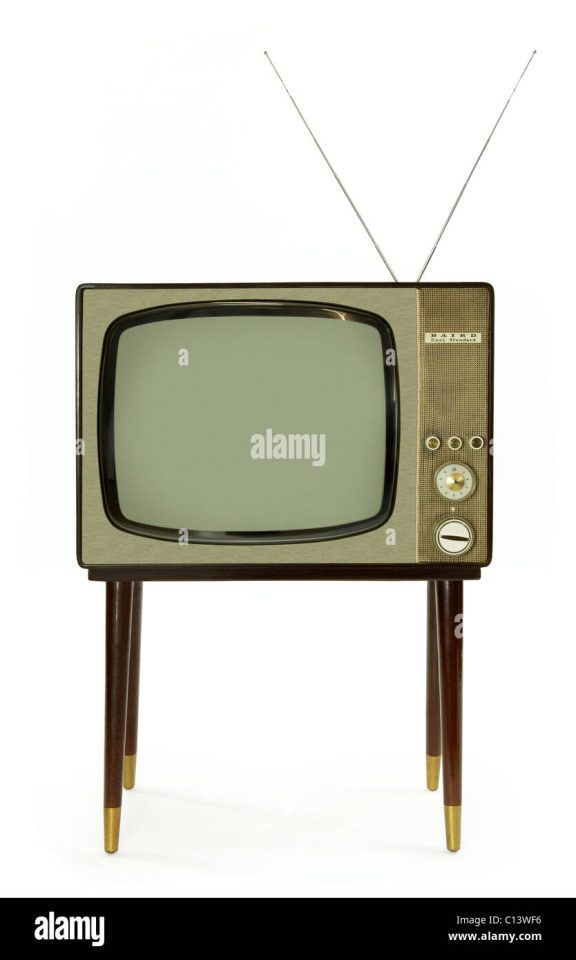
(below) 70s-80s CRT TV: Color TV became more affordable and commonplace.



(below) 90s CRT TV



(below) 2000s CRT to Plasma and LCD TVs: The three display technologies competed, but LCD won out in the end. Plasma and early LCD didn't look substantially different. Plasma was a little bulkier, but was still slimmer than CRT.



2010s and on: LCD improved with LED backlighting. But then OLED removed the need for backlighting entirely, which mixed the benefits of plasma and LCD. (Didn't bother to find a picture example. It's so close to modern at this point)
--Display technology-- (These overviews are very simplified)
CRT(Cathode Ray Tube)--Used through the 1900s to approx 2010. Monochromatic until Color TV developed aroung the 1950s. Worked via vacuum tubes and electron gun that lit up the pixels. They were bulky, heavy, and used a whole lot of power. Widely considered obsolete and no longer made. Video games made while these were in use tend to look better in CRT, since the graphics accounted for the image quality.
Flat screens-
PDP (Plasma Display Panel): Used from early 2000s to approx 2015. Used gas cells that light up pixels when electrically charged. Good image quality and good contrast, but expensive, heavy, and used a lot of power. Considered obsolete and no longer made, despite still having a desirable image quality.
Plasma and LCD competed in the 2000s to early 2010s as CRT popularity waned. LCD eventually won out due to weight and overall cost(including market price and energy efficiency).
LCD (Liquid Crystal Display): Introduced for TV around the same time as Plasma. Works via a liquid crystal layer with a backlight. Slim, decent image quality, energy efficient. Viewing angle matters because image colors are warped at wide angles. Cheaper than plasma. There are two main backlighting types:
--CCFL(Cold Cathode Fluorescent Light): Used fluorescent lighting for the backlight. Image quality was decent, but didn't have good contrast. (the blacks were never truly dark because of the backlight)
--LED(Light Emitting Diode): An LCD that uses LEDs instead of CCFL for the backlighting. Better contrast and efficiency than using CCFL.
OLED(Organic LED): Mixes strengths of plasma and LCD. Self emitting LEDs. No backlight or LCD panel needed, which improves contrast(about as good as plasma was, which is why plasma is basically obsolete now).
--QD-OLED(Quantum Dot- OLED) Adds a layer of Quantum dots to an OLED to improve color gamut. I think. I can't let myself fall too far into this rabbit hole, so I'm not double checking anymore.
((Feb 12, 2025-updated tags)
#hazbin hotel#hellaverse#hazbin hotel redesign#hazbin vox#vox#human vox#the vees#heavenbound au#a3 art#fanart#digital art#character sheet
157 notes
·
View notes
Text
PAC: Why Did You Reincarnate as a Woman?
For this Pick-A-Pile, I am going to continue with my Women’s History Month series, where I uplift, inspire and/or relate to women on this platform. This reading is a bit of a life path reading and a past life reading but it’s more general. So take whatever resonates and leave what doesn’t. Without further ado, please pick a pile!
Left-to-Right (1-3):



Pile 1: If you chose this pile, this is definitely for my girls who like to move around. I think that you’re someone who was meant to be rich, you definitely have expensive taste. In a past life, I think that you were into the esoteric world and into the arts. You dibbled and dabbled in a little bit of this and that. But I don’t think that you were able to find stability in your past life. But you had a clear vision for yourself. So this time, you’ve reincarnated as a woman to gain financial stability and independence from the debts of your past life. In past lives, you could have been non-committal or always wanting to rush into things. And as a result, you reincarnated without ever having a satisfied spirit. As women, we are expected to be the nurturers and sidekicks to men. But you, Pile One, are definitely the main character. You’re a free spirit and a force to be reckoned with. You follow the beat of your own drum. But remember that the goal is to feel happy with where you already are. Your spirit has a lot of fire but don’t burn it out trying to be everywhere all at once. You were born to be the non-comformist and that’s okay.
Signs: Gemini, Taurus, Leo, Sagittarius.
Cards Used: 7 of Cups, 5 of Wands, Queen of Discs, 9 of Discs, 2 of Discs, Ace of Discs, The High Priestess, The Hierophant, 3 of Swords, The Star, 4 of Discs, The World, 8 of Wands and Justice.
extras: beyhive. saweetie. white nails. green eyes. born with heart issues. short-term career path. life path number five. pirates. bohemian style. theatre kid. paint. big city girl.
Pile Two: If you chose this pile, you’re definitely someone who is described as a pure spirit. What’s funny is I channeled those Snapped interviews of people saying their friend was “the light in a dark room”. You have the tendency to make friends easily. You’re very introverted. That’s how it’s supposed to be. In a past life, you could have suffered from depression; perhaps you were in a mental hospital. You were burdened with a reputation that wasn’t true to your character. You were an outcast. Maybe you could predict death & people despised you for it. I think you felt unloved and misunderstood. This life is supposed to be a clean slate for you, Pile Two. I think that there was a lot of gossip about you. But this time, you carried over the scars from being a target of gossip. Maybe you feel like you don’t really have any friends. Maybe you have a weird relationship with trust & you end up trusting the wrong people/none at all. Maybe you keep people at an arms length but you’re still a friend to all. I think that you reincarnated as a woman to reclaim your power and the right to be here on this Earth. You make the world go round, Pile Two. Don’t forget that. Never feel guilty for having fun.
Cards Used: Justice, The Chariot, Knight of Wands, Page of Cups, 3 of Cups, 3 of Discs, King of Wands, 10 of Wands, Queen of Swords, The Magician, Ace of Swords, 9 of Cups, Ace of Cups (RX), Ten of Swords, The High Priestess, 7 of Cups, Queen of Cups and The World (RX).
Signs: Sagittarius, Scorpio, Aquarius, Libra.
extras: nurse. break my soul. ellie goulding. codependency. microsoft. computer geek. smiley emoji. venusian. dmv. pills. fasting. making friends with outcasts. working with autistic children/elderly people.
Pile Three: If you chose this pile, you’re probably a person who struggles with their faith. This doesn’t come from nowhere & it’s not new to you. It’s in fact true to you. Today, you’re described as someone who is rebellious or maybe even lazy, but somehow you never complain about your circumstances. You’re like Trish De La Rosa. You keep a job! But in a past life, you were like a moody teenager. You never really saw the good in things. You were very negative. You held grudges and shunned people if they pissed you off. You could have been a gang member or you were an advocate for civil rights. Either way, your mindset was very black-and-white, no in between. As a result, I feel like you can struggle with following the rules today. I also feel like you have the tendency to be anti-religion/anti-Christianity, which is the basis as to why you struggle with your faith. Someone could have told you that you had “loose” ways as a child and this lit a fire under your ass. Misogyny in the church, but also in general is a reason why you have this fighter spirit. You have a fighter spirit, Pile Three. You’re here as a woman to take back what’s yours. You’re here to help other women realize their worth, reclaim their sexuality and transmute their pain into something beautiful, Pile Three and you will do it successfully.
Cards Used: Nine of Swords, The Star, The Emperor, Ace of Wands (RX), Ten of Swords (RX), Two of Discs, Eight of Cups, Queen of Cups, The Sun (RX), 4 of Discs, The World, 4 of Cups, Justice (RX), 8 of Swords, The Lovers (RX), The Hierophant, Princess of Swords.
Signs: Scorpio, Aries, Capricorn, Pisces.
extras: detention. good luck charlie. rapper. obsessed with cats. megan thee stallion. enough (2002). independent women. scarlet red. queer rights activist.
#law of assumption#manifesting#neville goddard#hoodoo#tarot#tarotreading#astro notes#pick a card#pick a pile#divination#tarotcommunity#tarot deck#pick a reading#pick an image#pac reading#spirituality#tarot pull#tarot pac
502 notes
·
View notes
Text
Hnnng dehumanisation in Spies are Forever. Curt's “not a man, [he's] property of the United States government". Tatiana wasn't a child, she was an “instrument of war”, a “killing machine". It’s particularly poignant that Barb calls Curt property of their government, a cog in the machine, because she knows that she’s in the same boat, and in fact socially inferior to him as both a woman and a support worker to his more prestigious career. She herself has always seen and valued him as a person and is constantly trying to make him reciprocate. But he initially views her as just a cool gadget dispenser. Technology appears to be her only means of asserting her worth and earning people’s attention, which might be why she’s working on a global information network, essentially the internet - the ultimate technological platform for human connection and collaboration. Cynthia is so committed to overcoming her human vulnerability in order to be the best tool her country could possibly ask for that she poisons herself every day to build up an immunity. One of the villains is a literal Nazi who uses a literal puppet, and is himself an “expendable puppet”. And the other is Owen.
Owen's evil vision is "turning everyone into a spy", aka property. Instruments for him to conduct. Creating a global surveillance network, because the internet has as much power to distance and isolate people as to unite them. The machine failed him when he was a cog in it, so he aims to replace it with a more efficient one and control it this time; he cannot comprehend of any ethical improvement to or dismantling of the machine itself. His problem with spies is that they contaminate the ruthless political mechanisms with messy, fallible humanity... and vice versa. Agent Mega messed up the mission because he was human; Curt left his boyfriend for dead because he was a spy. You can’t be both. Person or tool. So Owen chooses the one that can’t be hurt. He willingly becomes a tool of CHIMERA, a living weapon. He kills and tortures hundreds of people, considers himself an actor in a story and others expendable characters, does everything he can to detach himself from ideas of personhood. “Who needs spies when a box in a room can do your job in seconds?" Humanity is worthless. Obsolete.
Except no, it isn't. Curt and his allies proves it. After the prologue, Curt simultaneously makes Owen’s mistake of binary thinking. First he wants to be purely a man, and an absolute wreck of one; then he wants to be purely the greatest spy ever, with no sentimental weaknesses. But he can’t maintain that divide. He has to be both. His team wins with their skills, training and expertise and by being human - social, irrational animals, working together, loving each other for the sake of it, acting spontaneously. They aren’t tools that Owen can perfectly predict or manipulate. Curt surprises him. And Owen, for all his icy calculations and grand talk, cannot escape his humanity any more than he can destroy Curt’s, as his last scene makes painfully clear. He lowers his gun like a person. His voice breaks like one. He bleeds like one. Meanwhile, Barb is a genius engineer and Tatiana is a master assassin. You’d think that their climactic moment of triumph would demonstrate Barb’s amazing inventions or Tatiana’s combat skill, but instead the focus is on them simply talking to each other and even Mrs Mega. Human connection and collaboration. Human error that doesn’t negate their victory. “You can break a computer box, but you can’t break the will of a man.” That’s what Curt is. Not property. A man. He is a gay, unemployed man; Barb is a woman in STEM; Tatiana is a female ex-KGB Russian immigrant; all in the United States of America in the 1960s, a very bad time and place to be all of those things. Yet they will survive. They are not alone and they will endure. Spies are forever because they are people.
And the narrative consistently emphasises that everybody is a person! It mocks the Nazis, obviously, but even then Baron von Nazi isn’t a one-dimensional monster, he has emotions and cognitive biases and a backstory and fondness for cheeseburgers. Sergio isn’t just an interchangeable criminal, he’s a devoted family man awkwardly trying to lighten his work atmosphere. Richard Big isn’t just a crass parody, he has moral principles. We hear all kinds of characters’ thoughts and feelings: the Informant, Barb’s fellow scientists, the waiter at the casino, the guests at the gala. This affirmation that everyone has a inner life means that yes, anyone can be a spy.
147 notes
·
View notes
Text
tw // pet death - but also cat photo dump
---
she came into my life on my fifth birthday, in 2008.

the shelter had named her amelia, but I couldn't pronounce it right, so the spelling was changed to amilea. she was a runt, the only survivor of her litter, and frankly swayed my concept of the normal size of a cat. she was my little baby to the end, and loved to be cradled like one. she's been the one constant through my life. when i lost friends i still had her to cuddle and love. she gave me sixteen years. she was a thief of chips and ice cream and aptly nicknamed 'satan' for her bitchy nature toward others.

my family used to have this stringy wallpaper that she was able to climb, and she would get up to eye level on the corner and wait for someone to come up from the basement to scare them. she hated strangers and all other animals excluding our family dog, buddy, who she took the time to groom and cuddle when she wasnt chasing him around.

she loved to sit on my shoulders and watch when i played piano or cooked. she never walked with her harness on, but she loved to lay outside with me while i read in the back yard.

when i moved out, i knew i had to have her with me. i never wanted to be apart from her. she slept in my bed every night right next to my head, spent the time i was at work sat on the windowsill watching birds until i got home. she insisted on sitting in my lap every time i was at my computer drawing, and screamed at me every time i sang too loud.

when her arthritis started to affect her i did everything i could to keep her comfortable. i put steps up to her favorite window sill, gave her a series of platforms to more easily get up on the bed. i had to make my bed a certain way because she refused to step on the comforter as she was losing vision and a black blanket didn't make for easy stepping at night. i put down padding around the bed for when she did fall off so she wouldn't get hurt, and made sure to give her ample room to lay any time so she wouldnt.

she passed away in my arms wednesday night.
she gave me sixteen years, and i will always cherish her.
64 notes
·
View notes
Text
I saw a post the other day calling criticism of generative AI a moral panic, and while I do think many proprietary AI technologies are being used in deeply unethical ways, I think there is a substantial body of reporting and research on the real-world impacts of the AI boom that would trouble the comparison to a moral panic: while there *are* older cultural fears tied to negative reactions to the perceived newness of AI, many of those warnings are Luddite with a capital L - that is, they're part of a tradition of materialist critique focused on the way the technology is being deployed in the political economy. So (1) starting with the acknowledgement that a variety of machine-learning technologies were being used by researchers before the current "AI" hype cycle, and that there's evidence for the benefit of targeted use of AI techs in settings where they can be used by trained readers - say, spotting patterns in radiology scans - and (2) setting aside the fact that current proprietary LLMs in particular are largely bullshit machines, in that they confidently generate errors, incorrect citations, and falsehoods in ways humans may be less likely to detect than conventional disinformation, and (3) setting aside as well the potential impact of frequent offloading on human cognition and of widespread AI slop on our understanding of human creativity...
What are some of the material effects of the "AI" boom?
Guzzling water and electricity
The data centers needed to support AI technologies require large quantities of water to cool the processors. A to-be-released paper from the University of California Riverside and the University of Texas Arlington finds, for example, that "ChatGPT needs to 'drink' [the equivalent of] a 500 ml bottle of water for a simple conversation of roughly 20-50 questions and answers." Many of these data centers pull water from already water-stressed areas, and the processing needs of big tech companies are expanding rapidly. Microsoft alone increased its water consumption from 4,196,461 cubic meters in 2020 to 7,843,744 cubic meters in 2023. AI applications are also 100 to 1,000 times more computationally intensive than regular search functions, and as a result the electricity needs of data centers are overwhelming local power grids, and many tech giants are abandoning or delaying their plans to become carbon neutral. Google’s greenhouse gas emissions alone have increased at least 48% since 2019. And a recent analysis from The Guardian suggests the actual AI-related increase in resource use by big tech companies may be up to 662%, or 7.62 times, higher than they've officially reported.
Exploiting labor to create its datasets
Like so many other forms of "automation," generative AI technologies actually require loads of human labor to do things like tag millions of images to train computer vision for ImageNet and to filter the texts used to train LLMs to make them less racist, sexist, and homophobic. This work is deeply casualized, underpaid, and often psychologically harmful. It profits from and re-entrenches a stratified global labor market: many of the data workers used to maintain training sets are from the Global South, and one of the platforms used to buy their work is literally called the Mechanical Turk, owned by Amazon.
From an open letter written by content moderators and AI workers in Kenya to Biden: "US Big Tech companies are systemically abusing and exploiting African workers. In Kenya, these US companies are undermining the local labor laws, the country’s justice system and violating international labor standards. Our working conditions amount to modern day slavery."
Deskilling labor and demoralizing workers
The companies, hospitals, production studios, and academic institutions that have signed contracts with providers of proprietary AI have used those technologies to erode labor protections and worsen working conditions for their employees. Even when AI is not used directly to replace human workers, it is deployed as a tool for disciplining labor by deskilling the work humans perform: in other words, employers use AI tech to reduce the value of human labor (labor like grading student papers, providing customer service, consulting with patients, etc.) in order to enable the automation of previously skilled tasks. Deskilling makes it easier for companies and institutions to casualize and gigify what were previously more secure positions. It reduces pay and bargaining power for workers, forcing them into new gigs as adjuncts for its own technologies.
I can't say anything better than Tressie McMillan Cottom, so let me quote her recent piece at length: "A.I. may be a mid technology with limited use cases to justify its financial and environmental costs. But it is a stellar tool for demoralizing workers who can, in the blink of a digital eye, be categorized as waste. Whatever A.I. has the potential to become, in this political environment it is most powerful when it is aimed at demoralizing workers. This sort of mid tech would, in a perfect world, go the way of classroom TVs and MOOCs. It would find its niche, mildly reshape the way white-collar workers work and Americans would mostly forget about its promise to transform our lives. But we now live in a world where political might makes right. DOGE’s monthslong infomercial for A.I. reveals the difference that power can make to a mid technology. It does not have to be transformative to change how we live and work. In the wrong hands, mid tech is an antilabor hammer."
Enclosing knowledge production and destroying open access
OpenAI started as a non-profit, but it has now become one of the most aggressive for-profit companies in Silicon Valley. Alongside the new proprietary AIs developed by Google, Microsoft, Amazon, Meta, X, etc., OpenAI is extracting personal data and scraping copyrighted works to amass the data it needs to train their bots - even offering one-time payouts to authors to buy the rights to frack their work for AI grist - and then (or so they tell investors) they plan to sell the products back at a profit. As many critics have pointed out, proprietary AI thus works on a model of political economy similar to the 15th-19th-century capitalist project of enclosing what was formerly "the commons," or public land, to turn it into private property for the bourgeois class, who then owned the means of agricultural and industrial production. "Open"AI is built on and requires access to collective knowledge and public archives to run, but its promise to investors (the one they use to attract capital) is that it will enclose the profits generated from that knowledge for private gain.
AI companies hungry for good data to train their Large Language Models (LLMs) have also unleashed a new wave of bots that are stretching the digital infrastructure of open-access sites like Wikipedia, Project Gutenberg, and Internet Archive past capacity. As Eric Hellman writes in a recent blog post, these bots "use as many connections as you have room for. If you add capacity, they just ramp up their requests." In the process of scraping the intellectual commons, they're also trampling and trashing its benefits for truly public use.
Enriching tech oligarchs and fueling military imperialism
The names of many of the people and groups who get richer by generating speculative buzz for generative AI - Elon Musk, Mark Zuckerberg, Sam Altman, Larry Ellison - are familiar to the public because those people are currently using their wealth to purchase political influence and to win access to public resources. And it's looking increasingly likely that this political interference is motivated by the probability that the AI hype is a bubble - that the tech can never be made profitable or useful - and that tech oligarchs are hoping to keep it afloat as a speculation scheme through an infusion of public money - a.k.a. an AIG-style bailout.
In the meantime, these companies have found a growing interest from military buyers for their tech, as AI becomes a new front for "national security" imperialist growth wars. From an email written by Microsoft employee Ibtihal Aboussad, who interrupted Microsoft AI CEO Mustafa Suleyman at a live event to call him a war profiteer: "When I moved to AI Platform, I was excited to contribute to cutting-edge AI technology and its applications for the good of humanity: accessibility products, translation services, and tools to 'empower every human and organization to achieve more.' I was not informed that Microsoft would sell my work to the Israeli military and government, with the purpose of spying on and murdering journalists, doctors, aid workers, and entire civilian families. If I knew my work on transcription scenarios would help spy on and transcribe phone calls to better target Palestinians, I would not have joined this organization and contributed to genocide. I did not sign up to write code that violates human rights."
So there's a brief, non-exhaustive digest of some vectors for a critique of proprietary AI's role in the political economy. tl;dr: the first questions of material analysis are "who labors?" and "who profits/to whom does the value of that labor accrue?"
For further (and longer) reading, check out Justin Joque's Revolutionary Mathematics: Artificial Intelligence, Statistics and the Logic of Capitalism and Karen Hao's forthcoming Empire of AI.
25 notes
·
View notes
Text










and if you need my love…. 😽
modern billy dunne x popstar! reader
tw not much yet! just the usual billy drinking smoking etc! allusions to smut but no actual smut
billy dunne hated pop music, hated the very nature of it, the way his manager pushed the band to lean more into their pop side in order to sell more albums. he’d worked his ass off to get where he was, long nights in his mom’s garage and perched in front of his computer mixing recordings, emailing promoters, anything to get this thing off the ground. you, on the other hand? you seemed to appear overnight, going from a minor celebrity to a global sensation, your debut album knocking the six right down the charts. what he hated even more than your success, or the lack of his own, was the way he couldn’t stop listening to your album. he wanted to say it was bullshit, that you weren’t talented, but he couldn’t even bring himself to lie. he wouldn’t seek it out-couldn’t stoop to that level- but when it inevitably came on, he’d never skip it, never turn it off. you had the alluring, pop princess act down to a science, he’d give you that. you had the perfect mix of ballads and upbeat, borderline explicit, songs. your image was polished, always pristine and dressed perfectly, always bright eyed and smiling. it drove him fucking crazy.
when you did some stupid, short form interview about your tour essentials, his name had come up. his manager practically broke down the door to his tour bus, demanding he watch the video. so he found himself, begrudgingly, searching up your name, clicking on the most recent pop-up. and there you were, in all your glimmering glory, telling the interviewer all about how you couldn’t live without your glossier lip balm or your favorite drink-sprite, also billy’s go to- or how you, most of all, couldn’t go a day without streaming aurora. “i listen to it when i’m getting ready, and let me down easy is on my pre-show playlist,” you told the camera, like you were dishing out some insider secret, “billy dunne is a total genius, i’d love to meet the entire band one day,” you continued on, but he had stopped listening, his ears buzzing. you thought he was a genius? you wanted to meet him? it pissed him off even more, the way he reacted to it, like some sort of awestruck fan. he was billy fucking dunne, what did he care if some popstar even knew he existed?
"we have to set something up," his manager advised, "i'll get in touch with her team and see what we can come up with, maybe a surprise at her show? or we could just start slow, have her meet with the band?" "absolutely not," he didn't even pause to think about it, "i have no interest in meeting her," "billy, come on," his manager shook his head, sighing, "don't be a kid about this. i'll send you an email when it's arranged," the finality of it all irritated him, got deep under his skin, but he tried his hardest to ignore it. maybe it would never even happen, he told himself, maybe you'd be too busy.
to his displeasure, two weeks later he was backstage at one of your shows, without the comfort of his band to keep him company. all alone, stuck listening to the hundreds of fans screaming for you, singing along to your songs like the gospel. he had just started to convince himself he wasn’t bothered, too zoned out to notice the music had ceased, when you bounded backstage, a vision in glittering pink platforms and a matching bodysuit. “oh, you came!” your voice startled him into action. he shot up out of his seat, forcing a smile onto his face, forcing his eyes not to linger on your body. “wouldn’t have missed it, i was flattered to receive the invite,” he extended a hand for you to shake, which you promptly swatted away, moving it to instead hug him, pressed against him like you’d known him for ages. “i’m such a huge fan,” you told him, voice slightly muffled by his shirt, “seriously, aurora is totally genius. did you write it yourself?” “uh, yes, i did,” his voice vibrated against your cheek as he spoke, and you pulled away after a moment, if nothing else than to watch him speak, “i wrote it over the summer after a pretty bad breakup,” “i’m sorry to hear that,” you smiled sympathetically, “at least you got a good album out of it,” “spoken like a true artist,” he joked, “that’s exactly what i thought,” “i need to go get changed and get out of the venue, but wait for me, kay? id love to chat more!” “yeah, alright,” he nodded, unsure why he was agreeing, “i’ll be here,”
you returned half an hour later, your stage makeup toned down, dressed in a sweatshirt and leggings, looking much less popstar and much more girl next door. “do you wanna grab a bite?” you asked, looking hopeful and sweet, “we can go out the back and take one of my cars so no one recognizes us,” “sure,” he found himself agreeing again, like you had some sort of spell over him, “you can pick the place, im fine with whatever,” he half expected you to take him someplace fancy, but your driver pulled into tue back lot of a dimly lit burger spot, all smiles as you led him inside. “i always come here when i’m in the city,” you explain as the two of you slide into a crinkly booth, “they have the best fries, i swear, they put this seasoning stuff on them and they’re just to die for,” “yeah?” he laughed, surprised by your enthusiasm about something so simple-maybe you weren’t as airhead as he thought? “i’ll just get whatever you recommend, since you’re the expert,” he shrugged, flipping through the menu briefly. you told the server you’d take a basket of fries and two strawberry shakes, and as you thanked her, billy was struck again by how down to earth you seemed. “so!” you leaned on your elbows, looking at him expectantly, “tell me everything! how’d the six get started?”
three hours later and the shakes were gone, the fry basket empty, and the diner was closing up around you. you talked about everything; how he started the band, how you got discovered, the writing process, your mutual obstacles with management. you had an air about you that he rarely found with other celebrities, like you’d just happened upon all this, like it was fun, not some hyper serious career. you were, annoyingly, the most beautiful girl he’d ever seen. he found himself more and more attracted to you with each joke or laugh, each new facet of your personality he discovered through the night. you insisted on paying for dinner, leaving an insanely generous tip and thanking the staff before ducking out the back, back to your car.
“i had fun,” you smiled, tucking a lock of hair behind your ear, “maybe we could meet up again while we’re both around?” “yeah, i’d like that,” he nodded, “we’ve got a show next week, i can send you a pass if you’d want to come?” “i’d love that!” you practically squealed with excitement, “thank you, that’s so sweet of you,” “least i could do to return the favor,” he shrugged, smiling, “hopefully we’ll live up to the hype,” “oh, i’m sure you will,” there was a pleasant silence for the rest of the drive until you pulled up outside of his hotel, and he nearly hesitated to get out, comfortable in your company. “so i’ll see you next week, then?” he gave you a half smile, smoothing out his shirt to busy his hands. jesus, what was he doing? he was billy dunne, not some lovesick teenager. “yeah, next week,” you nodded, smiling brightly, “thank you again for meeting me, i had such a good night,” “oh, the pleasures all mine,” he waved a dismissive hand, “really, you’re great,”
the silence was thick, heavy with stolen glances and blushed cheeks as his hand hovered over the door handle. “here, i can walk you to the door,” you offered, already unbuckling. “no, it’s okay, i can-“ “i want to,” you grinned, hopping out of the suv, waiting patiently for him to join you. he sighed, getting out and following you, “you’re pushy, aren’t you?” “mm, i like to think i’m just goal oriented,” you teased, “this hotels nice,” “it’s alright,” he shrugged, eyes lingering on your lips for a beat, “nor the nicest in the city,” “it’s cozy, though,” you countered, “much cozier than the ones downtown,” “maybe so,” he couldn’t tear his eyes away from you now, “i should head inside, i’d hate for you to catch a cold out here,” “yeah, alright,” you sighed softly, “goodnight, billy,” you turned on your heel, and his body acted before his brain, his hand on your elbow pulling you back to him, kissing you before he even hesitated to think if it was too fast. you made a small, surprised sound before kissing him back, standing on your tiptoes to wind your arms around his shoulders. he forced himself to pull away after a moment, already imagining what other sounds he could pull from you, how your like might feel somewhere else- god, he had to focus. “goodnight,” he smiled, nearly breathless, “i’ll see you soon,” “i’m looking forward to it,” you giggled, unwinding yourself from around him, turning for the car again, “night, rockstar,”
he was, as it turns out, an awestruck fan when it came to you. when he got in bed that night, he scrolled through countless interview clips, concert videos and photos of you with fans, unable to stop himself from digging deeper. he felt guilty, just slightly, when he stumbled upon a photo of you in a particularly revealing halloween costume for a show last year, his eyes tracing over every inch of you that he could see. 20 minutes later, when he’d come to the thought of your lips around his cock, he thought he’d probably taken it too far. but then he remembered the enthusiasm you’d had when he kissed you, and he thought maybe, just this once, his obsession could be returned. you were both artists, after all. who better to love until it drove you insane?
#billy dunne x you#billy dunne fic#billy dunne smut#billy dunne#billy dunne djats#djats billy#djats fic#djats x reader#billy dunne x popstar! reader
22 notes
·
View notes
Text
Understanding
Written for day 2 of Angstpril 2025, hosted by @chaos-company. Prompt: Chronic Pain Fandom: The Bad Batch Rating: Teen and Up Audiences Word Count: 2084 Summary: Wrecker's having a hard time dealing with his chronic pain after the accident that scarred his face, damaged his left eye, and damaged his brain. READ ON AO3
The flash of a blaster bolt was all it took for searing pain to stab into Wrecker’s head before turning into a spreading, throbbing ache, hurting more than it had in days. He’d started training again now that he was finally out of his fog. There was a lot of physical therapy, some cognitive therapy, but battle training took priority. He still had to function within his role in his squad.
The blaster bolt that had flared past his vision was only a training bolt, the light less intense than a true one, and it had his head hurting like someone or something had hit it.
A small moan left him and he leaned against the barrier in the training facility.
Crosshair was instantly in his comm: “You okay?”
Wrecker shook his head (bad idea), and tried to at least crouch to get out of harm’s way. He blinked his eyes repeatedly, not sure how to fix the pain in his head.
“Yeah,” he forced out.
“You do not sound okay,” Tech chimed in.
“Stay out of it,” Wrecker argued.
He wanted everyone to shut up and leave him alone.
His head hurt all the time now. Not so much his eye, thankfully, and the scars on his face were incredibly sensitive, even hot water that felt good on the rest of his body irritating them. But his head. Oh, his head! Would it ever stop hurting?
It was at its worst when he woke up, when he was taken to a medical wing instead of the mess with the others to receive his medicine.
He’d been told that if he couldn’t get off of them, couldn’t function without them, he’d be decommissioned.
That fear had kept him up all night, and he’d refused the meds this morning.
He figured it all contributed to the deep almost-cold ache he was feeling right now. It throbbed through the left side of his head, leaving him feeling almost fully blinded.
Wrecker wasn’t sure what was going on around him, but he tried. He tried to understand.
His brain was too busy hurting to compute.
Wrecker only really started coming back to himself when a droid fired at him. He took the hit, groaning at himself for not being able to dodge, or fight back. The others seemed to groan with him.
His reaction times were so slow that Hunter was on the droid, stabbing it, by the time Wrecker realized what was happening.
“Keep going,” Hunter said to all of them. “We still have to take that tower.”
Then he leaned in, putting a hand on Wrecker’s shoulder. “You okay, big guy?”
“I got a headache, Sarge.”
“If you need to wait in a safe place—”
Wrecker just about broke his blaster from how hard he smashed it against his knee. “I don’t want to wait in a safe place! I want to fight!”
His loud voice hurt his head, and he put a hand to it, groaning as he leaned over.
Hunter held him up.
“Hey, it’s okay. You can’t push it. It’ll just hurt you more.”
“I don’t want to be hurt,” Wrecker grumbled.
Hunter seemed to freeze at that, and then he took in a massive breath.
“I know, Wrecker. I know.”
This didn’t seem like the right moment to voice his fears, so he quietly relented to Hunter’s suggestion. Hunter helped him over to the platform they’d come in on, hiding behind a barrier. Droids likely wouldn’t be directed over here since they’d cleared this area. Crosshair was already climbing the tower.
Wrecker watched, missing all of it, missing himself, missing being there for his team.
“I’m useless,” he told himself.
***
“Get away!” Wrecker cried, shoving a droid away from him.
“CT-9903, it is imperative that you receive this dose of medicine.”
Wrecker growled and bared his teeth.
His head ached till everything was nearly blinding, but he couldn’t do it, he couldn’t face being decommissioned. He had to heal faster.
He had to be okay.
“I don’t need medicine,” he argued. “Just let me go back to my squad.”
“I cannot do that without you properly clearing these tests.”
Wrecker stood, shoving the droid back again. “Forget it. Just note I didn’t wish to comply or some shab like that. I’m outta here.”
Thankfully, the medical droid didn’t follow him as he left.
The white halls stabbed him, his left eye aching despite its blindness. And there was an ache behind it, begging him to lie down, and rest, to get some help. But he couldn’t do that.
This had to be manageable. It had to be.
All Wrecker could do was curl up in his bunk and pretend he was just tired, even as his head hurt too much for him to be able to eat.
***
Wrecker was moving slowly, taking longer to get ready than his squad, than he had before his accident with his own bomb.
He sighed. He was used to it by now, even used to the pain most days. Mornings were just… harder.
Echo was taking awhile to get ready, too.
He was newer to their squad, and Wrecker hadn’t told him about the pain in his head yet, but he wondered if Hunter had. Though, Echo had pain to deal with as well, it seemed.
Wrecker sighed at how long he was taking, at how slow his movements seemed, at how low his energy was. His hurt brain had to expend more energy than it used to just to have Wrecker look like he was functioning normally.
His stomach grumbled for breakfast, but he just sat down by the table Tech had all his strange and sometimes-annoying experiments on.
Echo sat beside him, still fitting armor over one of his mechno-legs.
“What’s up?” he asked Wrecker, tone casual.
Wrecker thought maybe he just didn’t want to make a big deal of this, and he appreciated it. The others had gotten used to Wrecker’s pain—Wrecker having gotten accustomed to it as well—but sometimes it still brought up a lot of fear and worry.
“Just tired,” he said. Then he admitted, “I wish I could move faster in the morning.”
“Me too,” Echo said. “Things just… aren’t like they were, you know?”
Wrecker glanced at him, at the one good limb he had. They’d often offered Echo help with various self-care tasks, but had learned that he liked to struggle on his own, just so he could learn, and he had learned.
Yet it must hurt not having all your limbs, missing most of your body.
“What hurts the worst?” Wrecker asked.
Echo shrugged. “Sometimes my legs, though they aren’t there. Though my right arm likes to ache like a karking mudscuffer in the morning. My shoulder too.”
Wrecker simply blinked at him, amazed that this cool, and collected clone had sworn so much.
“But you manage?” Wrecker asked him.
“I guess I have to. You?”
Wrecker nodded. He’d needed less meds, was better on missions, had been accepted despite knowing his brain was different somehow, that something had changed cognitively that he couldn’t put his finger on. The mornings were still so difficult sometimes, was all; like his brain liked to take its sweet time about waking up.
“Yeah,” he said.
Wrecker’s stomach grumbled again.
Echo put his scomp against his arm.
“Come on, let’s get some food. I’m sure it’ll wake us both up.”
Wrecker stood. “Yeah, sounds good.”
***
“Wow, your neck is really tight,” Omega said as she sat on a rock behind Wrecker, massaging him.
He hadn’t requested a massage, but she said she thought she knew of some way to help. Usually he had low-level pain in his head that he was used to and could function with, but he had certain triggers: poor sleep, too much alcohol or caffeine, stress, too many blaster bolts whizzing past in his vision…
He had been told a cybernetic eye could help since his right eye wouldn’t be trying so hard to create depth perception he couldn’t get back, but Wrecker didn’t want to go through more surgeries, didn’t want more needles or blades anywhere near him.
Now it was a bit too late for all that.
He hadn’t seen a blaster bolt in a long time, save for when Omega worked on her training.
She’d gone on a walk with him to get some flowers to brighten up the place, settling in all right to life on Pabu, when his head had started hurting quite a bit. He figured it was too much sun. Usually he’d ignore his headaches from sunlight, but this one had been bad enough for him to ask if they could sit. Now Omega was perched on a rock behind him, massaging his neck.
She pressed on a spot, and pain shot up straight into his head.
“Ow,” he complained, but didn’t pull away.
Omega’s hands were getting bigger, fingers longer. All of her was getting bigger, her growth spurts finally hitting her after Tantiss. Sometimes it was hard to believe, but other times she was just so beautiful that he couldn’t find the words for it, for what he felt from being privileged to see her grow up despite the time he’d missed when she was imprisoned.
And it was as if her heart grew bigger day by day. So it didn’t surprise Wrecker that she understood, that she was doing this for him.
“You know, you should really ask out that baker,” Omega mentioned all of a sudden.
Wrecker tried pulling away, but she motioned for him to stay still, jabbing at that spot that had the left side of his head hurting.
Then he laughed. “You can’t just spring this on me,” he said. “I have a headache—”
“You always have a headache.”
“—and you take advantage of my weakened state to get me to talk about Jama—”
“So that’s her name.”
“—like this? Then you tell me about Lyanna.”
Omega gave him a light slap on the shoulder.
“I am not talking about her. She’s just a friend.”
Wrecker chuckled, imagining the bright blush he was sure was on her face.
“So is Jama,” he said.
“Sure, like she sends fresh pastries to everyone.”
“She could.”
“Then where are mine?”
“Hey, I share.”
“You’re losing the point here.”
Wrecker couldn’t help smiling, even as she massaged at his neck. Then, something released, and he felt his left shoulder lowering, his neck relaxing more. A deep breath left him.
“Fine, maybe I do have feelings for Jama,” he admitted. “She’s pretty. I like how curly her hair is, and the warmth in her brown eyes, and—”
“Ooh, you’re in love!” Omega teased, getting another sore spot that sent a painful zing into his cheek.
“What if we send her some of these flowers?” she went on.
“Hey, it’s not really romantic if it’s your idea,” Wrecker argued.
“Shh, it totally is.”
“All right. But—but don’t tell Hunter. Or Crosshair!”
“My lips are sealed.”
“Or I’ll tell them about Lyanna,” he said, bringing out his blackmail.
Omega laughed, forgetting about massaging his neck for a moment, and just resting herself against him, blonde hair soft against his head and scars.
“They already know,” she laughed out.
“Wait, why am I the last one to know?”
Omega resumed her massage.
“Pfft, you think I wanted them to find out? You know how they are.”
“Dads,” Wrecker said, somehow summing up most of their personality these days, even as Omega said it with him, the word a loving grumble.
Another spot relaxed in his neck, and he was feeling a lot better. Wrecker cracked his neck, finally able to do so.
The cracks were so numerous that Omega giggled.
Wrecker stood, stretching. “Wow, that feels better!”
Then he grabbed the flowers, turning back the way they’d come, as Omega leaped down from the rocks.
“Wait, home is back that way,” she argued, pointing her thumb in the direction they had been going.
He gestured down the road with the basket of flowers. “Jama’s is this way.”
***
Batcher licked at Wrecker’s face before cuddling up with him. The night was quiet, but he’d left a sign on his door saying he wasn’t to be disturbed.
Curled up in the dark with his hound, feeling her breathe against him, he felt at ease, headache or not.
And out there, where there would be light and sound, there was a loving family who understood him when he was ready.
#angstpril2025#star wars#the bad batch#tbb#fanfiction#day 2#chronic pain#the bad batch wrecker#tbb wrecker#wrecker#angst#hurt/comfort#writing#my writing
12 notes
·
View notes
Text
💙 John Egbert's Glorious Return! 💙
(page 843-847)
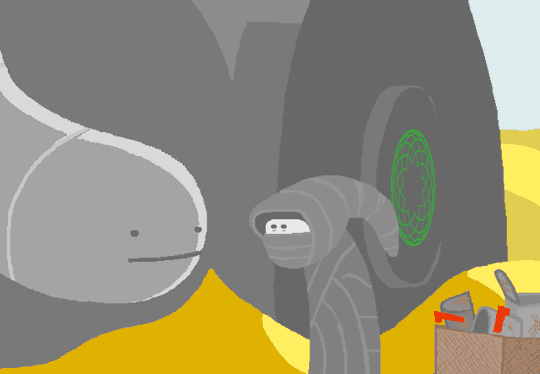
JOHN IS BACK!! HI JOHN I MISSED YOU <3
He is not doing so hot though. On top of making the dangerous, precarious decision to fight with an impressively bouncy weapon on a small platform above a bottomless pit, he’s clearly outmatched by these two giant ogres. The infinite loop of this animation is really well done, it genuinely feels like these two teams could stay in this stalemate for a while – until Rose gets back online and turns the tide, perhaps. And I laugh every time the grainy ‘Sassacre’ gets stamped over the otherwise very clean art style.
I’m really looking forward to Rose entering the Medium, so we can find out what’s specific to John’s game and what’s general to Sburb. For example, is it part of the game that a sprite will try to protect their assigned player? Or is it John’s nanna specifically (or the harlequin doll, I guess) who has that instinct? Do all sprites have the same powers (eye beams that destroy imps and heal players) or do the powers vary based on what’s prototyped?
I also want to know more about Jade’s predictions; it’s a fun narrative trick to have the reminder on her finger transition into another character, but has she literally seen a vision of this event in the same way that the Wayward Vagabond might watch this moment through a screen? (If so, is it possible she has these visions via her strange holographic computer?) Or does she have more of a vague understanding of things she shouldn’t, just ‘happening’ to be right as she does with the memory modus and the gadgets she’s created, a general sense of ‘John and his benevolent guide will have a challenging battle’?
I am DELIGHTED by the return of ‘Years in the future…’ followed by GameFAQs, and the fact that different characters have taken over these pages to mark a different act. In Act 2 we eventually learned that WV and Rose were in the same location; in Act 2 we already know that the Peregrine Mendicant and John are in the same place. I barely know the Peregrine Mendicant but I think they are so cool. They met a giant metal worm and got so angry when it ate one of their mailboxes (!) that they immediately reached for their sword, which incidentally is the first cool sword in Homestuck (not sorry, Dave). The cross on top of the sword looks like the cross usually found on the king in a chess set, so this must be a powerful sword from the dark kingdom, while PM is from the light. Could this be a clue to what happened in the battle of light and dark in John’s Sburb game?
Page 845 (incidentally one of my favorite pages in the comic so far) is the first time we’ve seen longform writing from John, and it’s a WHOLE new side to him. His character voice is a little different in this medium, but still recognizably John. And he is SO SO SMART, I apologize for everything I have ever said about John being bad at things and not sticking with them, because it turns out that ‘You like to program computers but you are NOT VERY GOOD AT IT’ (p.4) was just John’s low self worth and dismissal of his own skills, like here when he says ‘wow ok that pretty much looks like shit, but you get the idea’ about his cool ASCII art. Like, the John of page 843 is not in his element, he’s fighting two gigantic deadly foes when before today he’s never seen worse combat than being pied in the face, but the John of page 845 knows his shit, has reverse engineered some pretty complex mechanics from just a few punched cards, and is explaining it in terms easy to understand. And he’s making all these really clever leaps and he does brag about his ‘leet haxxor cred’ and he’s clearly excited about what he’s writing about, but I still feel like he doesn’t have much confidence, as he ends by deferring to Jade’s skills. I love how these two John pages are juxtaposed, and I cannot describe the pride I feel in seeing John really shine at something.
Goth queen Rose Lalonde has gone from cat mausoleum to vast, ominous green science lab full of uranium and/or slime, and I’m happy for pages like 840 and 847 that are primarily atmospheric, something I don’t think we’ve seen much of before. The lab’s logo reads ‘SN’, not the cool S, but one with an atom symbol in the upper curve and a spirograph in the lower – both familiar symbols, as both appear on Jade’s shirt (p.794), the atom appears on some of her inventions such as the wardrobifier (p.793), and the spirograph has appeared regularly as a symbol of Skaia. Could SN be SkaiaNet, developers of Sburb, first mentioned on page 114? If so, could Rose’s mom have something to do with the development of Sburb, potentially explaining why Mom knew to build a tunnel from the mausoleum to the lab if she’s had some visions similar to Jade’s. I think that would suck for Rose, as she’s worked hard to be independent from her mom and have her own interests, and to find out that her mom has been controlling her life in a pretty major way the entire time would probably be really hard to come to terms with.
I have been having loads of fun with this punch card calculator; more great work from Gankra, who has programmed several of the interactive pages including p.253. I would punch so many cards if I had a designix.
> John: Take another look at that rocket pack.

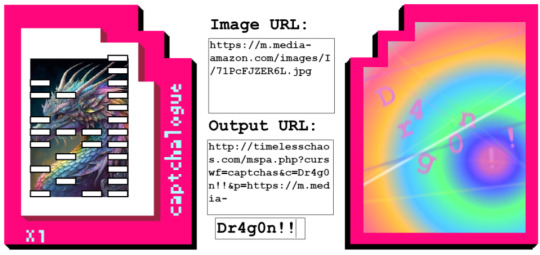
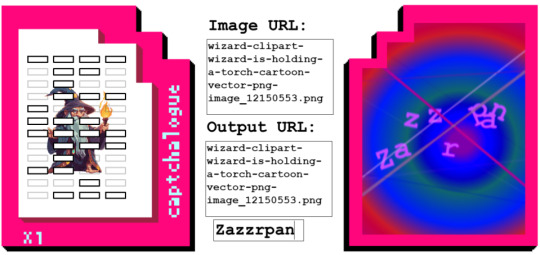
#homestuck#reaction#word limits? i never said anything about word limits on posts. you cant prove it#tomorrow i will be posting the longest post on this blog yet........#chrono
18 notes
·
View notes
Text
LEARN ABOUT IMAGE PROCESSING
Image fusion is a process where two or more images are combined to create a single, more informative or visually enhanced image. This technique is used in various fields like photography, remote sensing, medical imaging, and computer vision.

GET PARTICLE IMAGE PROCESSING VIDEO TUTORIAL 🦄
The goal of image fusion is to enhance the overall quality of the final image by combining information from multiple sources while retaining the most relevant details.
Feature-Level Fusion: Instead of combining pixel values, this method focuses on merging the features extracted from images. It's often used in computer vision for object recognition and tracking.
Libraries and Frameworks for Machine Learning Image Processing:
OpenCV-Python is a library of Python bindings designed to solve computer vision problems.
Huge library of image processing algorithms
Open Source + Great Community
Works on both images and videos
Java API Extension
Works with GPUs
Cross-Platform
youtube
#3d printing#ppt image process#image description in alt#image archive#image described#image processing#3d image processing#artificial intelligence#artificial image#techno animation#100 days of productivity#technoland expert#technoland facts#technoart#techno design#Youtube
8 notes
·
View notes
Text

Variety Interviews Ayo Davis, Meredith Roberts And Emily Hart On Disney Television Animation's 40th Anniversary And What To Expect On From The Past, Present And Future
40 years ago, Disney TVA was founded on the heels of challenging outcomes with features “The Fox and the Hound” and “The Black Cauldron.”
Initially, Disney TVA was restricted from using established Disney legacy characters, but nevertheless had huge successes with new shows like “The Wuzzles” and “Adventures of the Gummi Bears,” both of which became popular in syndication. As time went on, DTVA was able to use its limited rights to create shows like “DuckTales” and “TaleSpin,” which featured Disney characters. Today, the slate has evolved to include shows that travel across Disney’s streaming, linear and digital platforms, including Disney+, Disney Channel, Disney Junior and the Disney Parks
Over the 40 years of the studio has collaborated with Walt Disney Imagineering to bring beloved Disney Afternoon characters to the parks as well Mickey And Minnie's Runaway Railway and AquaMouse for the Disney Wish and Disney Treasure cruises from the Disney Cruise & Ships Line as well collaborating with Disney Yellow Two Shoes Team to redesing some heritage characters for the WDW Passholder Magnets.
Disney TVA characters also have gone to the realm of live action. In 2019 Disney Channel brought Kim Possible to the live action world as a Disney Channel Original Movie in 2019. In Spring 2022, Walt Disney Studios brought Chip 'n Dale: Rescue Rangers to a new generation of fans trought a meta-driven live action/animated hybrid film which won an Primetime Emmy Award for Best Feature Film.
In April 2024, it was announced that Kiara from The Lion King II: Simba's Pride created at Disney TVA will make her live action debut on the motion capture/computer animated film "Mufasa The Lion King" with the character being voiced by Blue Ivy Carter. In Fall 2023, it was announced that Blumhouse Television and Atomic Monster where developing a live action reboot of Gargoyles for Disney+.
The future of the studio looks bright as the studio is slated to debut it's 100th show overall "StuGo" in 2025, as well new interations of beloved classics like The Proud Family, Phineas And Ferb, Sofia The First and Darkwing Duck trought revivals,reboots and spin-offs in the coming years with early talks of new interations of TaleSpin, Kim Possible and Recess since Early 2023.
“We have a wildly diverse development slate because we don’t have a house style,” says Meredith Roberts, executive vice president, television animation, Disney Branded Television and CEO of Disney Television Animation “Our styles are creator-driven, so that allows for real support of the artist or creator to fulfill his or her vision. Anything is possible, whether it's CGI. (“Monsters at Work”), hand-drawn 2D (“Big City Greens”,"Primos","Hailey's On It!"), rig-based 2D (“Moon Girl and Devil Dinosaur”,"Kiff") and stop-motion (“Mickey Saves Christmas”,"Rhona Who Lives By The River".). Roberts continues, “We really try and solve all the problems and develop it. We look at the scripts and the story arcs. Every project has to have a strategy behind it that will complement the slate and separate it from other things. Each project has a distinct swim lane to attract an audience. And we’ve learned to meet the kids where they are, in terms of streaming and YouTube.”
Co-viewing, the viewership that happens when adults sit down to watch a DTVA show with the kids in their lives, is part of the studio’s secret sauce and long-term strategy. Many of the shows are written with jokes and plot points for both audiences so both groups will return.
“We double down on the kids and family space,” says Roberts. “We’re not just dipping a toe in the water. We’re diving in. I think we’ve seen a lot of churn with the competition, who just don’t have the patience to develop and are for this audience, which is a very specialized kid audience and co-view audience.” ("The Witchverse", "Rhona Who Lives By The River","InterCats","Fantasy Sports") Roberts reflects: “I think one of the things I’m most proud of is how stable Disney TVA has been for the last 40 years despite a lot of outside churn of the animation industry. Many of our crews feel that Disney is their forever home. I think the excitement they have to illustrate and create with this brand has been terrific because it’s harder to be funny and clean. And nowhere are we tearing down people to get that laugh. I think that’s the beauty of a Disney animated show.”
DTVA also sought to meet kids where they are by making their audience — which is made up of the most diverse generation in history — feel seen, with series such as “Elena of Avalor,” which featured Disney’s first Latina princess, and “The Proud Family,” franchise focused on the life of a teenage Black girl.
“We do have an amazing insights team that are constantly in the field, giving us general information about how kids are watching content, what they’re into,” Emily Hart (VP of Current and Development - Disney Junior) says. “Some of those things are evolving, as we know the ways kids consume content is changing. But there are some universal truths about kids, and it’s great to have that reinforced. Kids still like a lot of the same things that we like. So, there’s a combination that we’re always tracking with every new idea, and we do pilot testing. We get to sit down and talk about the content, and we invite our creators in so they can see the kids talking about it because they’re the audience and they’re the truest test of if the story is going to work.”
Ayo Davis, president of the Disney Branded Television and VP of Current and Development at Disney Television Animation says the division is a “driving force” for memorable kids and family entertainment.
“All of us at Disney Branded Television are so proud of the studio’s 40-year legacy as it continues to entertain future generations with shows like ‘Kiff,’ ‘Big City Greens’ and ‘Mickey Mouse Clubhouse 2.0" --- Davis says.
Those creators who come to DTVA often stay for a long time, partnering with the studio on a variety of different projects or expanding on a hit and reimagining it for the next generation of viewers. “The Proud Family” was a standout in 2001 on Disney Channel. Creator and executive producer Bruce W. Smith is now working on the Emmy-winning “The Proud Family: Louder and Prouder,” which is based on the original series. The show follows Penny Proud as she navigates family life and her own childhood.
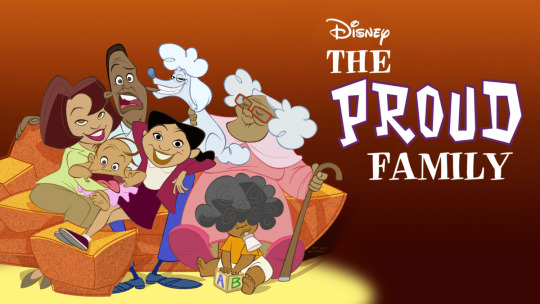
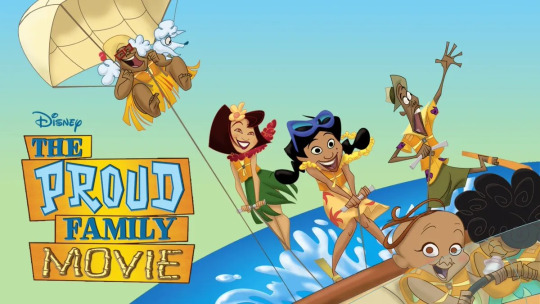
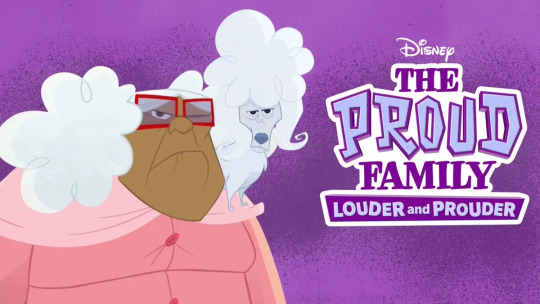
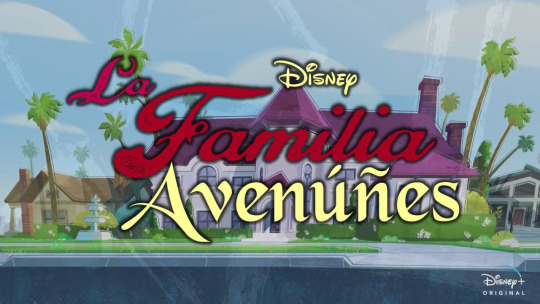
“Being at Disney TVA has allowed me to realize all my artistic dreams,” says Bruce W. Smith. “As a kid, you always have hopes, thoughts, dreams, ideas and characters that can help lay out those ideas in your head. Disney has allowed me to really tap into my creative instinct, at the end of the day, you have to learn how to trust yourself. Meredith Roberts has been a true shepherd for me in all of this, allowing me to stretch my wings. Because of her belief in me and my ideas, she’s really allowed me to blossom as an artist. All that happened at DTVA.”
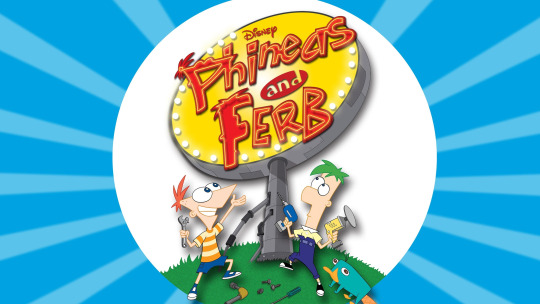
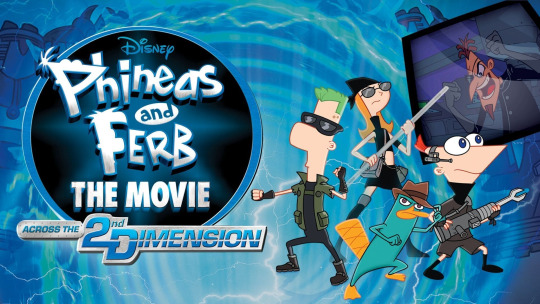
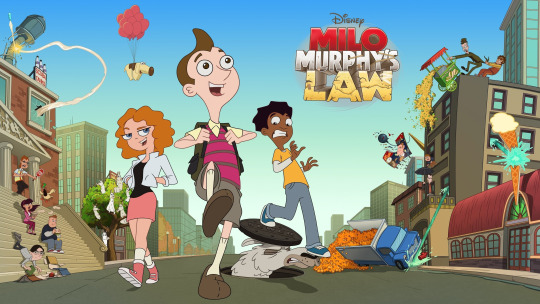
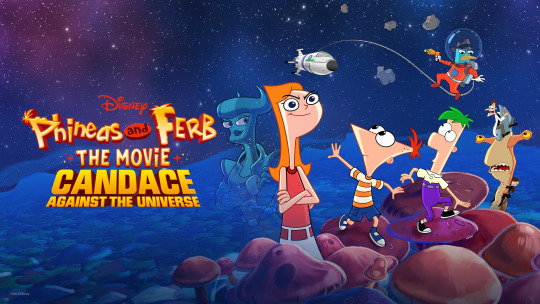
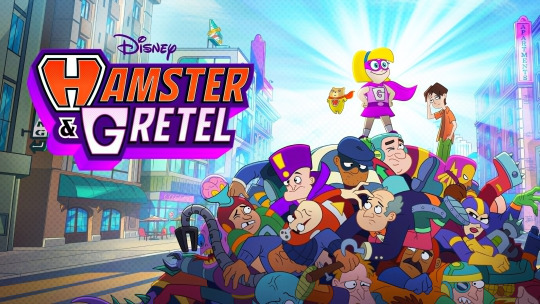
“They really seem to be a place that welcomes your ideas,” Dan Povenmire says of Disney TVA. “They want to find people with real strong ideas of the stories they want to tell, and then they let them tell those stories for the most part. They seem to put storytelling and characters over anything. With [‘Phineas and Ferb’], we would write jokes for the kids and the adults in the room because we knew the adults would be there too. We were just careful not to do any double entendres.”
#Disney Television Animation#Disney TVA#Disney TV Animation#DTVA#Ayo Davis#Meredith Roberts#Emily Hart#Dan Povenmire#Bruce W Smith#Gravity Falls#Big City Greens#Amphibia#Primos#Disney Primos#DuckTales#DuckTales 1987#TaleSpin#Darkwing Duck#Fantasy Sports#The Witchverse#InterCats#StuGo#Gargoyles#The Proud Family#Phineas And Ferb#Milo Murphy's Law#Star Vs The Forces of Evil#The Owl House#Kiff#La Familia Avenúñez
30 notes
·
View notes
Text

LEGO Almost Went Bankrupt. These Heroes Saved Our Bricks.
How a brain tumor inspired Bionicle, one of the most popular toys of a generation.
BY DAVID LUMB PUBLISHED: JUN 21, 2020

The Platinum Avohkii mask, a rare one- of-a-kind piece made of solid platinum purchased by Andre Hurley, who has The Bionicle Archives collection
Courtesy Andre Hurley/The Bionicle Archives
In 2003, LEGO seemed to be riding high after shrewd licensing deals brought Star Wars and Harry Potter sets to the masses. But unbeknownst to many—even those inside the company—sales were plummeting, and there were only guesses as to why.
Some blamed poor strategic choices in the 1990s—Legoland theme parks, forays into digital products—for LEGO’s hemorrhaging. All that misguided development time slashed profitability, and even Star Wars and Harry Potter sales shriveled between movie releases. It’s hard to conceive of now, but at the turn of the millennium, beloved LEGO might have been headed toward a pitiful end.
During this fallow period, one product line stood apart with startling, consistent success: Bionicle, a series of buildable action figures backed by rich worldbuilding and cross-platform promotion. Inspired by co-creator Christian Faber’s battle with a tumor at the base of his brain, the toy warriors of Bionicle wouldn’t just conquer their fictional enemies. They’d pioneer innovations that would transform LEGO and rescue the company from possible doom.

Courtesy Andre Hurley/The Bionicle Archives
Today, Christian Faber looks a bit like a Danish Paul McCartney. His youthful smile pairs well with his genial nature, which one might mistake for meekness until he starts talking about his creative projects. The 54-year-old embodies the unchecked enthusiasm you’d expect from a 28-year veteran of LEGO projects. If Faber’s long-time illness dimmed his appetite for play, you wouldn’t know it.
In 1986, Faber began working for Advance, a Copenhagen- based marketing firm that partners with LEGO. But shortly after his career began, Faber’s vision began to falter. A doctor found a benign tumor inside Faber’s pituitary gland that was impeding his sight, a condition called prolactinoma. Doctors said the tumor was maybe in the least accessible spot in the body for surgery, so they prescribed Faber daily medication to keep the tumor from growing. Among the drugs’ side effects, however, were severe nausea and dehydration, effectively sidelining Faber from social activities.
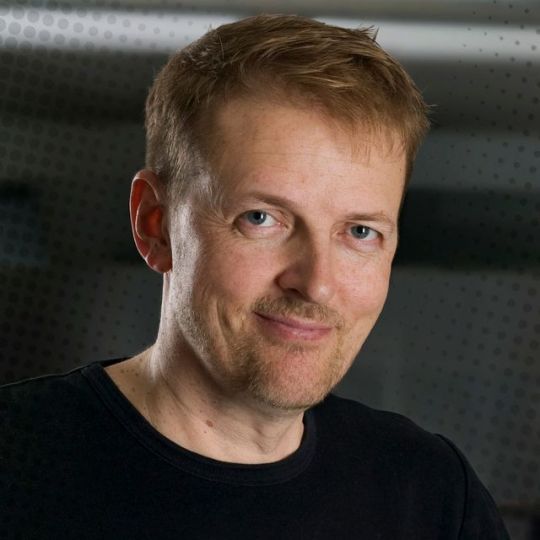
Courtesy Christian Faber
“It was the strangest mix of feelings,” Faber says. “I was happy at the job, but faced the physical and mental strain of the medicine and a long-term illness.”
Faber’s side effects attacked him hardest in the mornings, so he found most of his energy for work at night. Early in his career, Faber designed brochures for LEGO toy lines. Exposure to the different products, including the undersea-based Aquazone and the sophisticated Technic series, gave him experience with LEGO’s standards and practices—a moving target in the mid- 90s, when the rise of computers and video games pressured LEGO to move from their traditional years-long R&D cycle toward what Faber calls ‘craze products,’ toys tuned to current market tastes with a planned one-year shelf life.
The craze-products movement was rife with experimentation for LEGO, and it materialized soon after a medical breakthrough for Faber. After 10 years of daily medication, Faber’s physicians moved him on to a new treatment which, in Faber’s own words, gave him his life back. The new treatment was a regular injection scheduled just once every two weeks, allowing Faber to engage with the world relatively free from side effects. He could chase higher ambitions than brochures, and he had an idea for a new kind of LEGO toy: a sort of Bionicle precursor called Cybots.
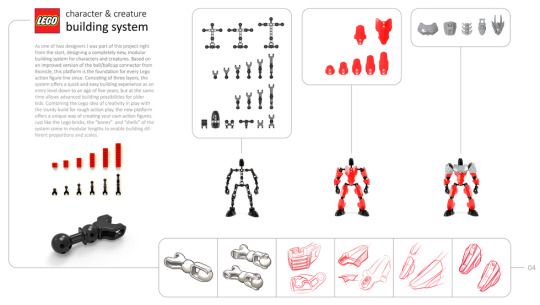
Courtesy The LEGO Group
“I was sitting with LEGO Technic and thought I would love to build a character instead of a car,” Faber says. “I thought of this biological thing: The human body is built from small parts into a functional body just like a model. What if you got a box full of spare parts and built a living thing?”
With his assistant graphic designer Jan Kjær, Faber pitched Cybots, a line of humanoid action figures with attachable limbs and ball-and-socket joints. LEGO didn’t furbish Cybots, but they would implement Faber’s concepts in craze products like Throwbots in 1999 and RoboRiders in 2000. By 2001, LEGO was testing a line called Bone Heads of Voodoo Island—masked robots with heads that could shoot off their bodies like Rock ‘Em Sock ‘Em Robots. Most of Bionicle’s look had been seeded: masks, buildable bodies, articulate limbs.

Courtesy Andre Hurley/The Bionicle Archives
Bone Heads of Voodoo Island was a bust—focus groups demonstrated kids didn’t respond well to detachable heads—so that same year, LEGO pivoted to focus on Bionicle. The plan was to take a more holistic design approach with these new toys than with craze products, but LEGO extended that comprehensiveness to the worldbuilding around the toys, too, a new strategy for the company. Faber and LEGO design manager Martin Riber Andersen were joined by former BBC film and TV executive Bob Thompson and writer Alastair Swinnerton to refine the Voodoo Island concept and pitch a new story. Faber, fresh from working on Star Wars LEGO sets, imagined something massive.
“After being on Star Wars, I was thinking that the only thing to do from here is our own stuff, but it should be as big as Star Wars,” Faber says. “It should be a big, full universe.”
For the storyline, Faber drew on his experience with prolactinoma. To him, his every-other-week injections seemed like sending in a new wave of protectors to battle his tumor with every dose. Faber imagined this group of disease-fighters arriving on an unknown beach with no memory. The story of these warriors would be called Bionicle, a portmanteau of ‘biological chronicle.’
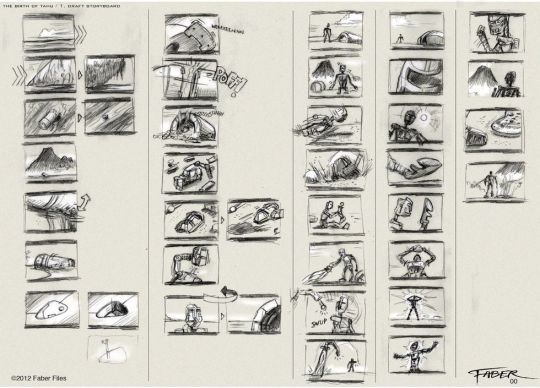
Courtesy The LEGO Group/Christian Faber
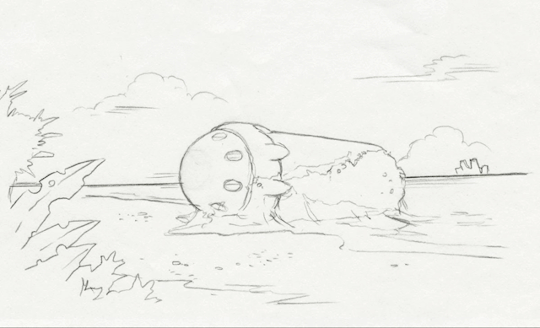

Courtesy The LEGO Group/Christian Faber

Courtesy The LEGO Group/Christian Faber
“We took an episodic story line but chose not to play it out in any single medium,” Thompson told Kidscreen in 2003. “We would take that story and scatter it like a paper trail through different types of media.”
Bionicle’s in-world story evolved through comics and chapter books, written in large part by Greg Farshtey of LEGO’s promotional periodical LEGO MANIA Magazine (also known as LEGO Club Magazine, but now called LEGO Life Magazine). Farshtey followed Bionicle’s story bible from the original team, but as he began accounting for character changes correlating with new toy sets, he added his own takes. By the end of Bionicle’s run in 2010, he had interwoven the story with three feature films and shepherded the comic series that, at its peak, reached almost 2 million readers per month, making it the most widely circulated monthly comic on the planet.

Courtesy Andre Hurley/The Bionicle Archives
By all accounts, Bionicle was the hit LEGO needed. In 2001, its first year on the market, the line brought in over $160 million in sales, it was declared “Most Innovative Toy of the Year” by the Toy Association.
"Flat sales and profit decline made LEGO believe the brick was passé and it needed to move to digital and virtual toys to remain relevant,” David Robertson, author of LEGO history book Brick by Brick, told Popular Mechanics. “But as Bionicle became a success, LEGO learned the difference between sufficient and necessary. It wasn't sufficient to just offer customers another box of bricks, but it was necessary. If a LEGO toy didn't have interlocking plastic pieces, consumers didn't want it. But to succeed and grow, it was necessary to embed a story in that box of pieces and tell that story through comics, books, video games, movies, and events at the LEGO Stores."

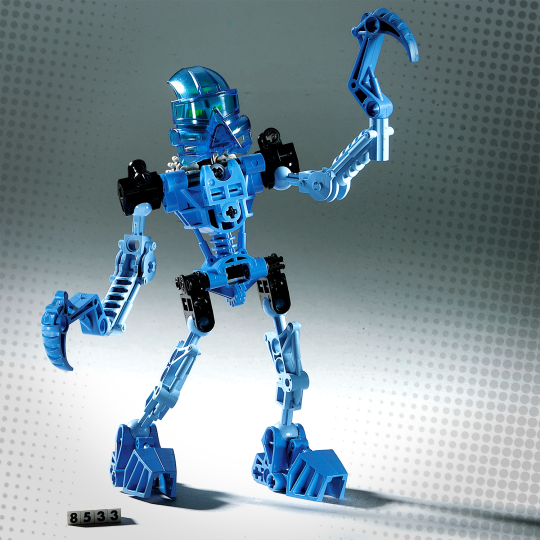
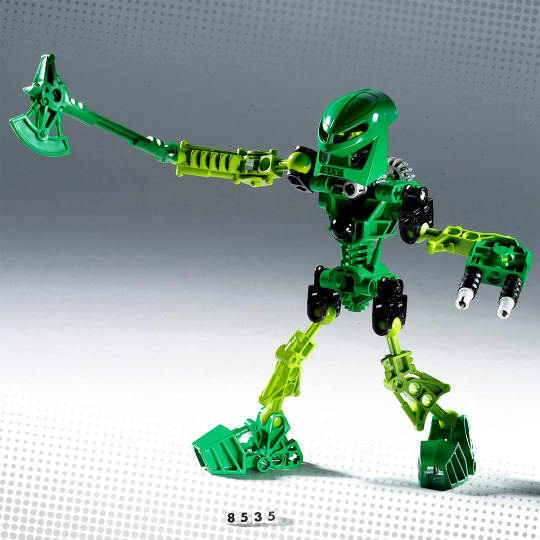
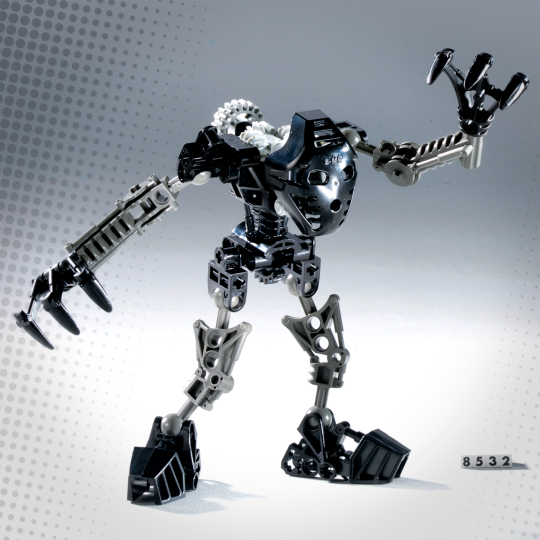
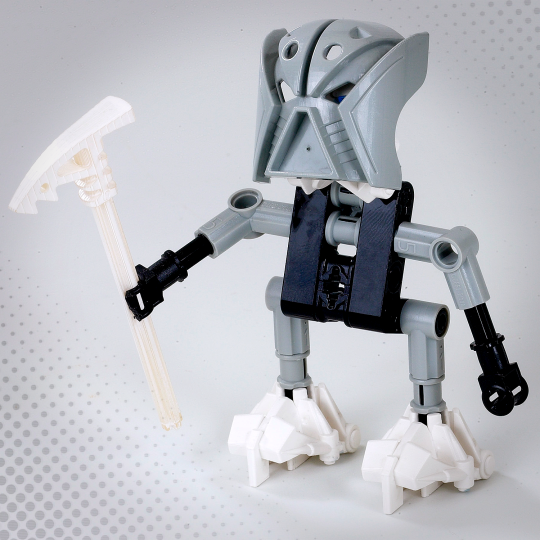
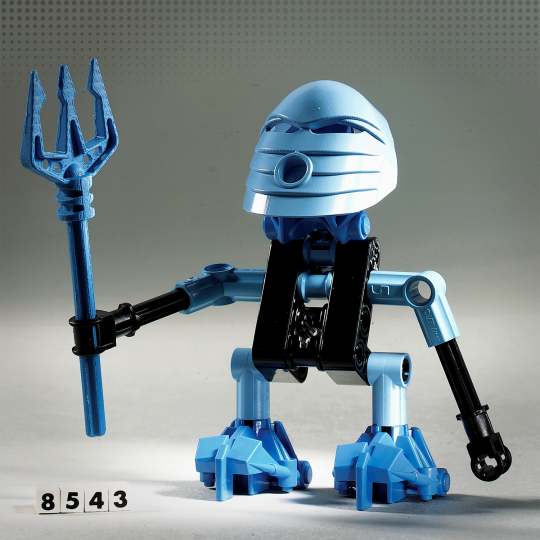
Courtesy The LEGO Group
In other words, Bionicle had all the ingredients of a fun LEGO toy, but Faber’s inspiration was key to making it a smash. “[My condition] had a direct effect on my career, and especially on the creation of Bionicle,” he says, ticking off the allegories. “A biological robot attacked by ‘illness,’ waiting for the right ‘medicine’ to arrive. Even the canisters the Toa warriors arrived in resembled the medicine capsules I had to eat every day.”
Bionicle hit its stride just as LEGO’s financials were bottoming out. While LEGO flirted with bankruptcy in 2003, Bionicle accounted for 25 percent of the company’s total revenue and 100 percent of its profits. As LEGO slashed its workforce, reduced the number of pieces it produced, and increased its range of licensing deals, Bionicle continued to diversify. Partnerships spawned. There were Bionicle-branded Nike shoes, McDonald’s Happy Meal toys, even Colgate toothbrushes. The cross-promotion paid off: By the end of Bionicle’s initial run in 2010, it sold over 190 million toys.
All the newness shook up LEGO’s tried-and-true project structure. Bionicle’s multifaceted development process blended design, marketing and engineering teams to hash out new sets, ingest market feedback, receive directives from LEGO executives, and issue their own directives to subsequent narrative and design teams. Under the new dynamic structure, development time for a new toy line at LEGO accelerated from three years to less than one. The rapidity created an exciting energy.
“We broke a lot of new ground experimenting and pushing boundaries,” Bionicle co-founder and design manager Martin Riber Andersen says. “One of the key ethos of the core team was this is a shared collaboration: We stand together. We all believed it was so in contrast to ‘the normal LEGO company’ that we might as well direct our energy to the team instead of our individual career objectives.”

Courtesy The LEGO Group
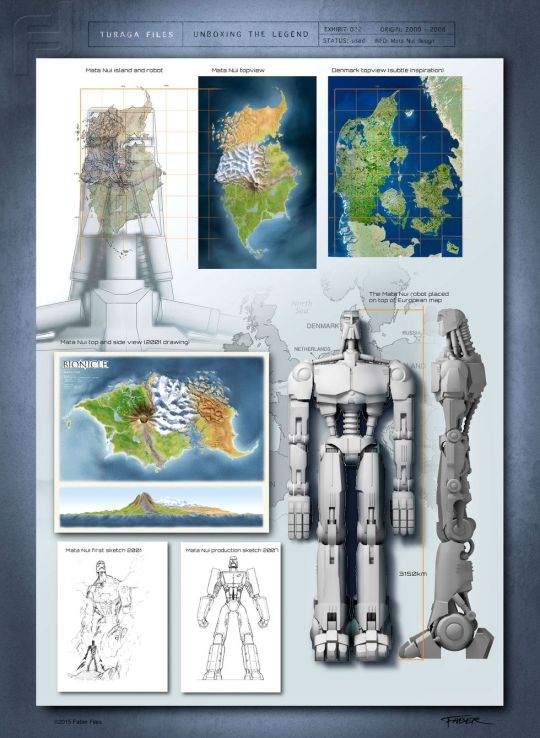
Courtesy The LEGO Group/Christian Faber
From 2003 to 2005, Bionicle was the reported top-performing LEGO toy line, but after that, sales dipped below expectations. The decline continued to 2009, when LEGO handed down word it was time to end Bionicle. The creators wrapped up the narrative in 2010, but it was hard to let go. Farshtey wrote Bionicle stories on the now-defunct BIONICLEStory.com until 2011, fans dissected the line’s mythology on BZPower forums, and custom Bionicles continued to appear. In 2016, Faber wrote to series fans: “The stories we hear and the stories we tell shape who we are and what we do ... through almost 30 years [of my career in storytelling], no story has proved this stronger than Bionicle. The fans were, are, and will be the true heroes of this ... great adventure.”
These days, you still see Bionicle at toy conventions, and the r/bioniclelego subreddit is alive and well. In fact, the front page of Reddit was graced in November 2019 with an essential, timeless question: “What is the appropriate amount of time to wait before showing your new significant other your Bionicle collection?”
The toys’ invigorating combination of articulate LEGO figures and intricate, multimedia story resonated with the LEGO company as well as fans. The brickmakers use the business strategy they honed on Bionicle with lines like Ninjago today, to great success.
"It's hard to overstate how important the Bionicle line was for LEGO,” Brick by Brick author Robertson notes. “Without the sales and profits of Bionicle in 2003 and 2004, the company would not have survived. Bionicle taught LEGO that success depended on the ability to hook kids on characters and story, and LEGO was smart enough to spread those practices throughout the company."

Courtesy Andre Hurley/The Bionicle Archives
After Bionicle, Swinnerton moved on to write children’s books and TV scripts, Andersen took on a senior position
at a European consulting agency, and Thompson founded a media production and consultancy firm. Farshtey, meanwhile, still edits LEGO’s free fan magazine. All cite Bionicle as high points in their careers.
“We should all be proud of what we achieved individually,” Thompson says. “But in my view, more important is what we did collaboratively. After all, LEGO fans are still talking about what we did with Bionicle—after two decades.”
Faber moved on from his design job at Advance in 2014 after 28 years working on LEGO. His medical journey continues to inspire his creative work, including a post-apocalyptic world he’s designing filled with adventure, danger, and a pro- environmental bent. Looking back, Faber sees the impact his illness and treatment had on the stories and projects he’s touched. Almost 20 years after co-creating the action figures that sustained LEGO through one of the darkest times in its history, talking about Bionicle still makes him reflective.
“Biology is a balance more than a battle between good and bad,” he says. “Ever since Bionicle, balance has been my goal in the stories and pictures I create.”

Courtesy The LEGO Group/Christian Faber
article graphics faber bs01
83 notes
·
View notes